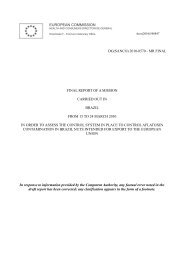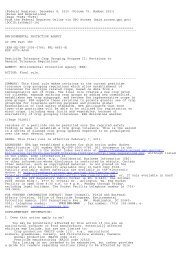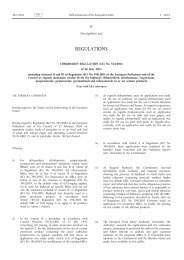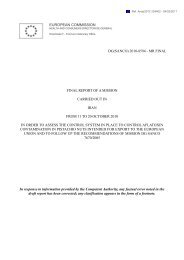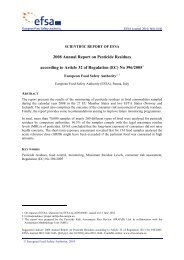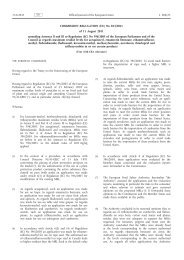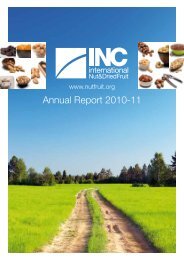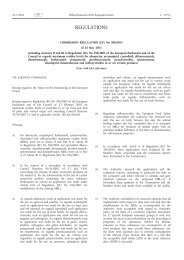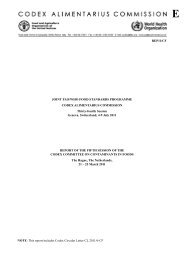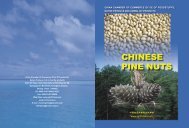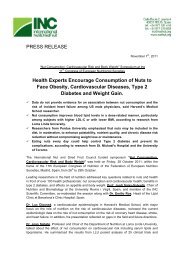REP11/PR JOINT FAO/WHO FOOD STANDARDS PROGRAMME ...
REP11/PR JOINT FAO/WHO FOOD STANDARDS PROGRAMME ...
REP11/PR JOINT FAO/WHO FOOD STANDARDS PROGRAMME ...
Create successful ePaper yourself
Turn your PDF publications into a flip-book with our unique Google optimized e-Paper software.
<strong>REP11</strong>/<strong>PR</strong> Appendix X 101<br />
Precision data derived from inter-laboratory studies (Collaborative Studies and PT Studies)<br />
11. The results reported for inter-laboratory studies are subject to both imprecision and bias. If such studies involve a sufficient<br />
number of laboratories and are designed to cover real test conditions (range of analytes and matrices), the reproducibility standard<br />
deviations obtained will reflect the typical errors likely to be encountered in practice. PT study data therefore may be used to provide<br />
reasonable estimates of measurement uncertainty.<br />
12. Collaborative studies on methods are generally well defined with well documented instructions on the analytical process and<br />
usually only involve expert laboratories with reputable experience in residue analysis. Under these conditions the analytical variance<br />
is likely to be the best achievable when applying the method under reproducibility conditions, particularly as error contributions from<br />
sample in-homogeneity are likely to be negligible. Providing a laboratory can demonstrate an ability to achieve the analytical<br />
performance associated with a particular collaborative study, the reproducibility standard deviation obtained for the study will be a<br />
good basis for estimating MU. A competent laboratory however, should be able to improve on the inter-laboratory method precision<br />
when conducting the method under within-laboratory reproducibility conditions, and hence reduce the MU.<br />
13. If certified reference materials (CRMs) are employed in collaborative studies, the study report should provide an estimate of the<br />
bias of the method against the ‘certified’ value and this will need to be taken into consideration when estimating the MU.<br />
14. In PT studies, it is normal for laboratories to employ their own test method for analysis. The method may be a standard method,<br />
a modified standard method or a method developed and validated in-house. Furthermore, there is generally greater variability in the<br />
analytical competence of the participating laboratories than is the case for collaborative studies. Because of these factors, the<br />
reproducibility standard deviation obtained for PT studies is likely to be larger than that anticipated from a method-based<br />
collaborative study. MU based on such data may be larger than the estimates reported by many participant laboratories.<br />
Nevertheless, an estimate of MU based on a PT study involving laboratories with a range of expertise using a variety of methods<br />
may be more pragmatic and useful for judging compliance of food commodities with respect to pesticide residues in international<br />
trade. The 50% default MU applied by the EU member states is based on PT data for a range of pesticides and food matrices.<br />
15. Whether or not a laboratory uses PT data to estimate MU, the information from PT studies is useful to compare and verify<br />
estimates based on data such as in-house validation or quality control experiments.<br />
MU derived from in-house validation and quality control data<br />
16. There is general consensus amongst chemical metrologists that the best source of uncertainty data on the analytical process is<br />
derived from the laboratory’s method validation and/or verification studies and long-term quality control data. This is based on the<br />
assumption that the laboratory has undertaken validation and/or verification studies and has sufficient experience to have built up<br />
long-term bias and reproducibility data on suitable quality control (QC) samples, CRMs, reference materials (RMs) or matrix spikes.<br />
17. The limited availability of CRMs for pesticide residues in food matrices usually requires laboratories to focus on spiked samples<br />
or other suitably characterised samples for internal quality control. The use of matrix-based QC samples such as samples with<br />
incurred residues, left-over PT study samples or spiked residue-free laboratory samples provides laboratories with a capability to<br />
monitor and control method (and analyst) performance while gathering information on both bias and precision. Control charts are<br />
excellent tools for evaluating long-term precision and monitoring statistical control of the analytical process.<br />
18. Bias, where significant, and the uncertainty of bias, should be considered when estimating MU. This is illustrated in the example<br />
discussed under paragraph 5.4.<br />
19. Bias can best be determined from the use of CRMs. However given the paucity of CRMs for pesticides in food and the large<br />
number of pesticides normally incorporated into a multi-residue screen, it is generally necessary to rely on the recoveries of spiked<br />
matrix samples to provide information on method bias.<br />
20. The performance of laboratories in PT studies can further provide a useful indication of the bias of individual laboratories against<br />
the consensus values and, in some instances, the spiking level of the PT samples. However, bias should be based on or confirmed<br />
by the results from a number of PT studies before it is used as an input in the estimation of MU.<br />
Worked Examples<br />
21. The following worked examples describe acceptable procedures for estimating MU based on different combinations of in-house<br />
validation data, in-house precision data and inter-laboratory data. The Horwitz equation and results from PT studies further provide<br />
useful benchmarks for comparison with in-house MU estimates.<br />
The following worked examples use hypothetical data for chlorpyrifos as a typical pesticide residue and draw heavily on examples<br />
presented in Eurolab Technical report No 1/2007 [1] and the Nordtest Report TR537 [2].<br />
5.1 Estimating MU using the Horwitz Equation<br />
The Horwitz equation expresses reproducibility standard deviation as a function of analyte concentration.<br />
u′ = 21-0.5 log c<br />
where u′ = relative reproducibility standard deviation<br />
c = concentration of analyte (in g/g).



